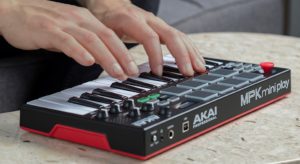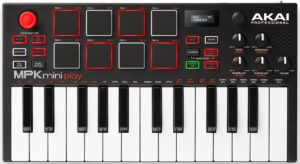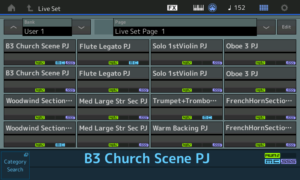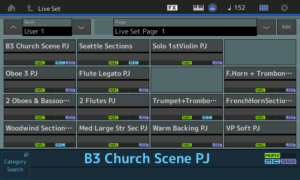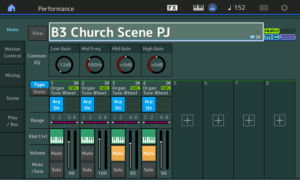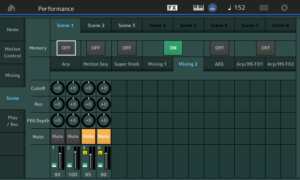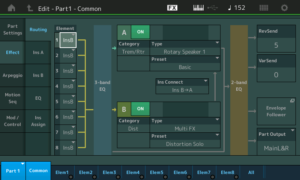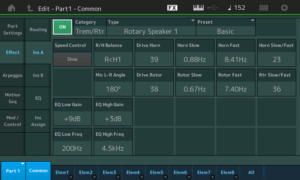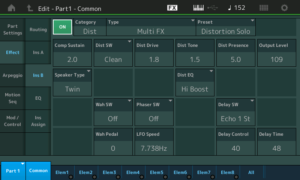I went in to play the 88 and walked out with the 61.
It isn’t because I don’t like the Yamaha MODX8 — it comes down to repertoire, need and gamey heart rhythm. If I could schlep the Montage 6 (33 pounds), I would have bought the Montage ages ago. 🙂
I dropped by my local GC knowing that they had a MODX6 in stock. I was hoping to try the MODX6, but found an 88-key MODX8 set up and waiting. As it was with the Montage launch, Yamaha laid out a little extra promotional money and the MODX8 was driving a pair of Yamaha HS8 monitors. Nice. Extra nice, it was raining like crazy and nobody was in the store. GC took a little bit away from the experience by hooking up a truly beat-out sustain pedal and cheap-ass cables to the HS8s. Life is never perfect.
The MODX8 is a very nice instrument. I spent 20 or so minutes jamming and generally had a blast. The hand-to-sound connection of the multi-part CFX grand piano is excellent, IMHO. This is a good keyboard for piano. Organ, not so much. The keys cut my hands when doing palm swipes. I played long enough to verify that all of the Montage sound is in the MODX. Thank heavens I had wrung out the Montage quite heavily when comparing Montage versus Genos™ and knew what to listen for.
BTW, I stick by my earlier comment. It’s a long reach to the MODX8’s pitch bend wheel, MOD wheel and assignable function (AF) buttons. This is the only genuinely negative thing that I can say about the MODX8.
Stop arguing on-line about the action. (And DACS. And touch screens.) Go play one. If you like it, buy it. The MODX8 — or any other instrument — is what it is.
I hadn’t really planned to buy the MODX6 that day, but the trade-in offer was quite decent. The dealer also allowed the usual minus 10% off given during GC trade-in, trade-up promotions. I suppose I could have bargained harder…
My first reaction while unboxing — damn, this thing is small and light. The MODX6 is a pound lighter and several inches shorter than my beloved MOX6. Hurray, I can use my current gig bag! Moving the PB and MOD wheels back let Yamaha cut inches from the overall length. I’m surprised that the front-to-back depth was not increased to accommodate the color touch screen. Good industrial design.
The plastic chassis does not feel as robust as the MOX6. This is just about the only negative. The MOX6 has stood up to guitars clunking into it and relatively light travel abuse. I hope the MODX6 will prove to be robust, too. My main gripe is the fit of the plastic end cheeks (end panels). They seem a little flimsy compared to the single molded shape of the MOX6. On the other hand, I think of the 88-key MODX8 as rather sturdy.
Certain compromises are made by all manufacturers when producing a mid-range model and the MODX is no exception. The quarter inch jacks are mounted directly on a printed circuit board (PCB) and are a little wobbly when compared to an up-scale model like the Genos. All of the controls give a nice resistance. If you’re an MOX/MOXF player, you’ll be right at home.
The touch screen is the same size as the Montage, which is smaller than the Genos screen. I’ve been spoiled by the Genos! I made a few tentative experiments at performance editing and find that I need to tap the screen with more care and precision than Genos, simply because the danged on-screen widgets are smaller.
Speaking of editing, I was able to create some layers and splits without cracking the manual. One big “However”. I know the Yamaha voice architecture and approach to voice editing quite well already. A novice will need time to get up to speed. I suggest reading the first chapter or two in the MODX Reference Manual and skim the Owner’s Manual before doing anything.
About the MODX6 keybed. Yes, it’s different than the MOX. Phil Clendeninn, on the Yamaha Synth site, mentioned that the keybed is new, even with respect to the MOXF models. The black keys have a nice texture adding a little “warmth” to the touch. The keybed is similar to the keys belonging to mid-range Yamaha arrangers. Yes, these keys are light and they are not FSX like the Montage and Genos. I don’t think this is a deal-breaker. I can perform palm swipes with ease and found the similar feeling S950 keys to be robust enough.
I’m now in the process of porting over my voices and performances from the MOX6. There is a direct migration path from MOXF to MODX, but not MOX. Yamaha usually support direct migration from the previous generation (singular), not two or three generations back. The port shouldn’t be too bad as I have only ten or so splits/layers built from scratch. All other MOX6 voices are based on factory patches which are present on the MODX, too. Those edits will be simple tweaks like dialing back reverb, extending release times here and there, etc. I eventually want to exploit the shining beacon known as the “Super-Knob” and scenes. In the meantime, I’ll be happy to start small and build Live Sets equivalent to my MOX6 set-up.
So, there you have it — my first report from the field.
Before signing off for today, I’d like to say “Goodbye” to an old friend: the PSR-S950 that I traded in. I had a lot of quality time with that ‘board and some lucky customer is going to get a gently used instrument. So long!
Update. Literally. The MODX6 had version 1.00 installed. I decided to update to 1.10 before creating too many performances and the possibility of losing data. First, the download from Yamaha was extremely slow. The first two downloads failed. Next, the read me document recommends formatting the USB flash drive on the MODX. USB drive usage information is split between the Owner’s Manual and the Reference Manual. I had to search on “format” in order to find the relevant text in the Reference Manual. The Reference Manual doesn’t have an index! Finally, the formatting directions are minimal (2 sentences?) and are not easy to understand.
Actually, I need to ding Yamaha for the overall quality of the Owner’s and Reference Manuals. The grey-scale screenshots are so small as to be unreadable and unusable. Both documents read like a direct translation from Japanese and both documents need to be edited by a native English tech writer.
Copyright © 2018 Paul J. Drongowski

